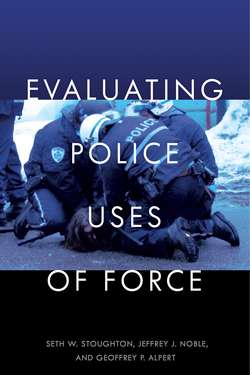Читать книгу Evaluating Police Uses of Force - Seth W. Stoughton - Страница 46
На сайте Литреса книга снята с продажи.
Criminal Law
ОглавлениеWhat we commonly refer to as a “crime” is, in somewhat technical terms, the commission of a certain action or actions that, when performed under certain circumstances or when they result in certain consequences, have been identified as criminal. Criminal statutes identify the behaviors, circumstances, and consequences that are the “elements” of a crime: a crime is committed when all of the elements are satisfied.
Consider, for example, South Carolina Code § 16-4-600(E)(1), which states, in part, “A person commits the offense of assault and battery in the third degree if the person unlawfully injures another person. . . .” Parsing that clause into its constituent parts, we see that assault and battery in the third degree consists of three elements: it is a crime for someone to (1) unlawfully (2) injure (3) another person. If any of those three elements are lacking, then the crime of assault and battery has not been committed. If, for example, an individual unlawfully injures a toaster, they have not committed the crime of assault and battery because the third element—“another person”—is not satisfied (although they may have committed a crime other than assault and battery).
As that brief summary of statutory elements suggests, state criminal law regulates a range of behaviors, prescribing punishment for a variety of social harms. Providing a complete list of relevant behaviors is outside the scope of this book, especially given the potential for the criminal law to vary significantly from state to state. Nevertheless, we can offer some general guidance as to the behaviors that are both common in use-of-force situations and are commonly regulated by state criminal law.
Assault: threatening or attempting to physically touch someone else against their will;
Aggravated assault: making threats of physical harm with a weapon or in circumstances that suggest particularly severe harm;
Battery: touching or striking someone else against their will, offensive touching, or causing actual bodily injury;
Aggravated battery: causing serious injury or causing injury to particularly vulnerable victims such as children or the elderly;
Murder: the intentional killing of a human being in cold blood (often referred to as an “intentional” killing or a killing “with premeditation” or “with malice aforethought”) or the unintentional killing of a human committed with callous disregard of the risk to human life (often referred to as “depraved heart murder”);
Manslaughter: the intentional killing of a human being in hot blood (often referred to as a killing after “adequate provocation”) or the unintentional killing of a human being resulting from recklessness or criminal negligence;
Kidnapping: restricting another person’s movement or forcing them to move from one location to another against their will;
Attempt: intending and actually trying, unsuccessfully, to commit some underlying crime. For example, planning and attempting to kill another person would not constitute the crime of murder because it did not result in a death, but it could constitute the crime of attempted murder; and
Conspiracy: entering into an agreement to commit some underlying crime. For example, planning with another person to kill someone could constitute the crime of conspiracy to commit murder.
State criminal law could potentially apply to a range of actions that officers might take in a use-of-force situation: it is not at all uncommon, for example, for an officer to threaten to use force (assault), to tackle, handcuff, and search the subject (batteries), and to secure them in a police vehicle and transport them to a booking facility (kidnapping). Obviously, we use this example to demonstrate that state criminal law is potentially implicated when an officer uses force, not to suggest that an officer’s actions, taken in the normal course of their duties, will amount to crimes. In this section, we are concerned only with identifying the type of actions regulated by state criminal law. Later in this chapter, we provide a more in-depth discussion of how to determine whether state criminal law applies in any given case.
